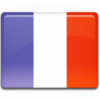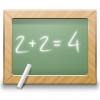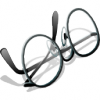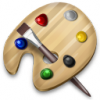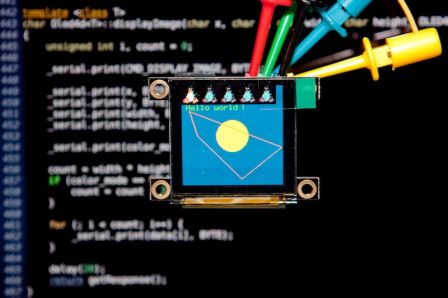Un exemple d'utilisation de la bibliothèque Oled4d pour Arduino
Voici un exemple très simple expliquant l'utilisation de la bibliothèque libre Oled4D dont j'ai parlé dans un précédent billet.
Ce programme va afficher l'image ci-dessous :
Le code source commenté est affiché en seconde partie de ce billet.
Plus d'informations :
Voici les étapes à suivre pour tester cette bibliothèque :
- Décompresser l'archive dans le dossier libraries
- Ouvrez l'environnement de développement Arduino
- Dans le menu Fichier > Exemples, il doit y avoir un menu Oled4D > Example > Demo, cliquez dessus pour l'ouvrir
- Compilez et chargez la cible
Voici une partie du code source (la déclaration de data_image à été tronquée volontairement), l'exemple va afficher un écran bleu, affiche un cercle jaune, 1 tux, réalise 4 copier / coller de l'image du tux, affiche du texte « Hello world ! » puis créé un polygone.
/* Oled4d Programme d'exemple pour interface Arduino / Écran Oled de 4DSystems */ #define RED RGB(255, 0, 0) #define GREEN RGB(0, 255, 0) #define BLUE RGB(0, 0, 255) #define YELLOW RGB(255, 255, 0) #define WHITE RGB(255, 255, 255) #define BLACK RGB(0, 0, 0) #define SMALL FONT_5X7 #define MEDIUM FONT_8X8 #define BIG FONT_8X12 #include <NewSoftSerial.h> #include <HardwareSerial.h> extern HardwareSerial Serial; #include <Oled4d.h> NewSoftSerial serial(2, 3); // count : 1152 #define DATA_IMG_WIDTH 24 #define DATA_IMG_HEIGHT 24 char data_image[] = { 0x0, 0x0, 0x0, 0x0, 0x0, 0x0, 0x0, 0x0, 0x0, 0x0, 0x0, 0x0, 0x0, 0x0, 0x0, 0x0, 0xc6, 0xc6, 0xff, 0xff, 0xff, 0xff, 0xff, 0xff, 0xff, 0xff, 0xff, 0xff, 0xff, 0xff, 0xbe, 0xbe, [...] 0x0, 0x0, 0x0, 0x0, 0x0, 0x0, 0x0, 0x0, 0x0, 0x0, 0x0, 0x0, 0x0, 0x0, 0x0, 0x0, 0x0, 0x0, 0x0, 0x0, 0x0, 0x0, 0x0, 0x0, 0x0, 0x0, 0x0, 0x0, 0x0, 0x0, 0x0, 0x0, }; void setup() { Serial.begin(9600); // Mode série pinMode(2, INPUT); pinMode(3, OUTPUT); // Configuration de l'interface série logicielle serial.begin(9600); } void loop() { // Créer l'objet en interface série logiciel Oled4dSoft oled = Oled4dSoft(serial, 8); // Pour utiliser l'uart « hardware », procéder ainsi : //Oled4dHard oled = Oled4dHard(Serial, OLED_RESET_PIN); // Initialise l'écran oled.init(); // Efface l'écran oled.clear(); // Fond d'écran bleu oled.setBG(RGB(0, 0, 128)); // Dessine un cercle oled.drawCircle(64, 64, 20, RGB(255, 255, 0)); // Affiche l'image oled.displayImage(0, 0, DATA_IMG_WIDTH, DATA_IMG_HEIGHT, COLORMODE_65K, data_image); // Copier / coller de l'image 5 fois for (int i = 1; i < 5; i++) { oled.screenCopyPaste(0, 0, i * DATA_IMG_WIDTH, 0, DATA_IMG_WIDTH, DATA_IMG_HEIGHT); } // Affiche du texte oled.drawText(1, 3, SMALL, GREEN, "Hello world !"); // Dessine un polygone char array[] = { 10, 32, 20, 64, 76, 120, 127, 64 }; oled.drawPolygon(sizeof(array) / 2, array, RGB(255, 128, 0)); while (1); }
Voilà, je pense que le code est assez explicite, en cas de souci, n'oubliez pas le forum d'aide.






